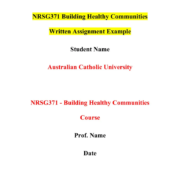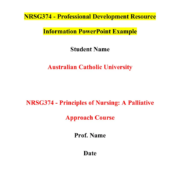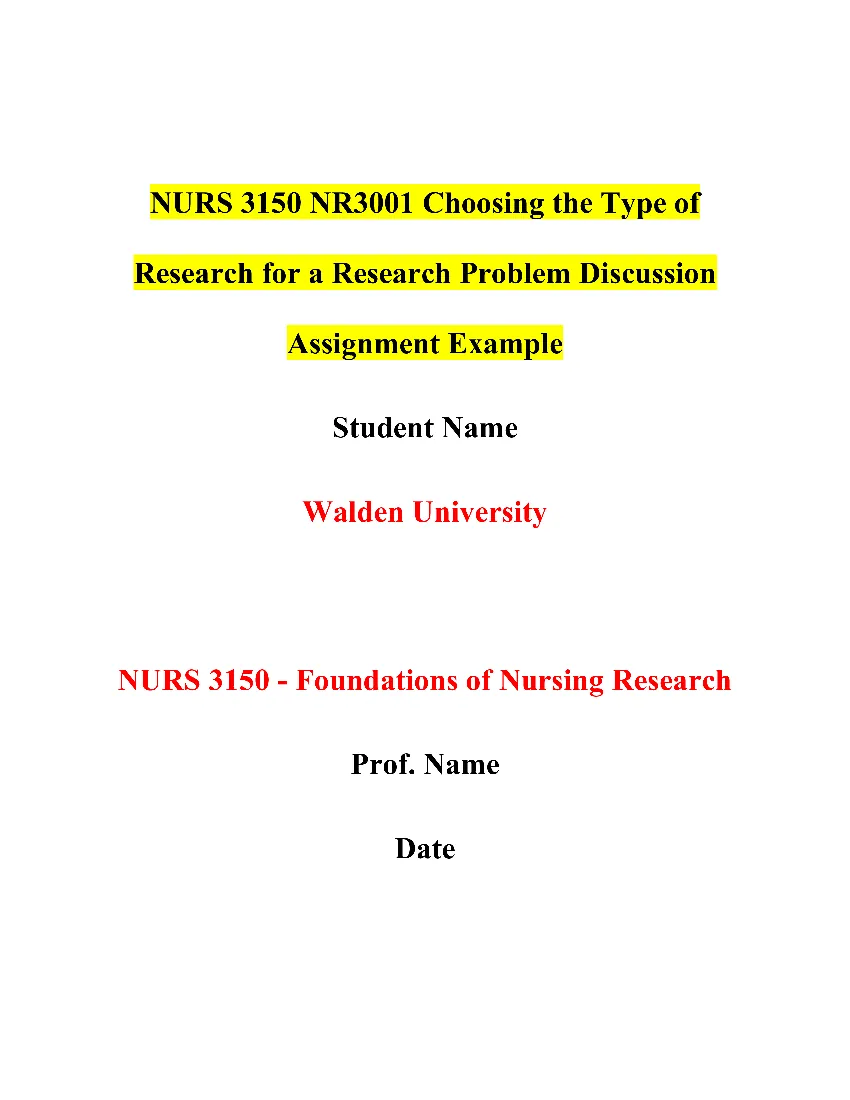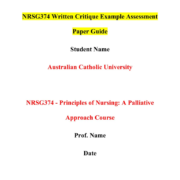ANP-650-Adult-Gerontology Acute Care I Example Assignment
 ANP-650-Adult-Gerontology Acute Care I: Assignment Brief
ANP-650-Adult-Gerontology Acute Care I: Assignment Brief
Overview:
The ANP-650 course focuses on preparing learners for the role of an Adult-Gerontology Acute Care Nurse Practitioner (AGACNP). The course is structured around key objectives, each designed to equip learners with the knowledge and skills necessary for effective AGACNP practice. This assignment brief provides an overview of the topics and assessments in Topic 1 and guides learners on how to approach and fulfill the requirements.
Understanding Assignment Objectives:
- Summary of Current Course Content Knowledge:
-
- Objective: Assess and articulate prior knowledge of weekly objectives.
- Guidance: Reflect on your familiarity with the weekly objectives. Identify objectives where you have prior knowledge and those where you lack familiarity. Consider how this self-assessment informs your approach to the course.
- Class Introductions:
- Objective: Introduce yourself and express expectations and challenges.
- Guidance: Share your excitement for learning and identify what you find challenging. This introduction serves as a foundation for building a collaborative learning environment.
- ANP-650-Adult-Gerontology Acute Care I Topic 1 DQ 1:
- Objective: Develop clinical objectives and a plan incorporating course objectives.
- Guidance: List clinical objectives aligned with course goals. Provide a 250-word plan detailing how you intend to apply course objectives and clinical practice guidelines in your clinical experience. Support your plan with at least two APRN-approved scholarly resources.
- ANP-650-Adult-Gerontology Acute Care I Topic 1 DQ 2:
- Objective: Understand regulations governing AGACNP practice in California (or your respective state).
- Guidance: Acknowledge reading the Nurse Practice Act for California (or your state). Identify professional codes and business practices regulated by the California Board of Nursing. Explain standardized procedure guidelines, outline two standards for nurse practitioners, and discuss regulations for medication ordering. Support your response with a minimum of two APRN peer-reviewed resources.
- AGACNP Program Plan for Required Experience:
- Objective: Develop a plan for clinical/practicum rotations.
- Guidance: Create a detailed plan outlining the type of rotations, hours, and preferred locations. This plan can be inspirational, practical, or a combination. Share your thoughts on future plans post-program.
- Prepracticum Preceptor, Faculty, and Learner Conference and Evaluation:
- Objective: Participate in a pre-conference meeting with preceptor and faculty.
- Guidance: Review and sign the “Prepracticum Preceptor, Faculty, and Learner Conference and Evaluation” form. Discuss course goals, learner expectations, and potential projects during the clinical/practicum experience. Ensure timely submission of required documents.
The Student’s Role:
As a learner in ANP-650, your role is crucial. Actively engage in self-assessment, contribute to class introductions, thoughtfully respond to discussion questions, and meticulously plan your clinical/practicum rotations. Familiarize yourself with relevant regulations and collaborate with preceptors and faculty to ensure a successful clinical/practicum experience. Your commitment to these activities will enhance your understanding of AGACNP practice and contribute to a successful learning journey.
Detailed Discussion Assignment Instructions: Assessment Description
Topic 1: Scope of Practice and the Role of the AGACNP
Max Points: 77
Objectives:
- Describe the role and scope of practice of the Adult Gerontology Acute Care Nurse Practitioner (AGACNP).
- Describe the role of the AGACNP in assessing patients and designing evidence-based treatments.
- Distinguish national, state, and local regulations as they affect AGACNP scope and practices.
- Document indications and contraindications for invasive treatment procedures occurring in an acute care setting.
Assessments
Summary of Current Course Content Knowledge
Assessment Description
Academic engagement through active participation in instructional activities related to the course objectives is paramount to your success in this course and future courses. Through interaction with your instructor and classmates, you will explore the course material and be provided with the best opportunity for objective and competency mastery. To begin this class, review the course objectives for each Topic, and then answer the following questions as this will help guide your instructor for course instruction.
- Which weekly objectives do you have prior knowledge of and to what extent?
- Which weekly objectives do you have no prior knowledge of?
- What course-related topics would you like to discuss with your instructor and classmates? What questions or concerns do you have about this course?
Class Introductions
Assessment Description
Take a moment to explore your new classroom and introduce yourself to your fellow classmates. What are you excited about learning? What do you think will be most challenging?
ANP-650-Adult-Gerontology Acute Care I Topic 1 DQ 1
Assessment Description
Review the course objectives and consider how you can develop the specified skills and competencies while applying clinical practice guidelines as an AGACNP providing patient care and creating appropriate patient-centered care plans. List three to five clinical objectives and write a 250-word summary of your plan to incorporate the course objectives and clinical practice guidelines for your clinical experience. Include discussion of what you hope to achieve. You will refer back to this information during Topic 16 when you are asked to reflect on your clinical objectives. Support your summary and recommendations plan with a minimum of two APRN-approved scholarly resources.
ANP-650 Objectives
- Understand and evaluate the strength of evidence in medical literature to apply to practice caring for acutely ill patients.
- Develop physical assessment and history-taking skills and apply critical thinking and decision-making to avoid unnecessary tests and procedures to develop differential diagnoses.
- Achieve competency in the technical skills of intubation, central line insertion, arterial lines, chest tubes, suturing, and lumbar puncture.
- Thoroughly and accurately document a patient’s history and physical, SOAP note, and progress note in the medical record.
ANP-650-Adult-Gerontology Acute Care I Topic 1 DQ 2
Assessment Description
For California-based learners, review the advanced practice rules for nurse practitioners in California using the resource, “Board of Nursing Links by State,” located on the college page of the Student Success Center under the AGACNP tab.
In your response, acknowledge that you have read the Nurse Practice Act for California. Identify the professional codes and business practices regulated by the California Board of Nursing for nurse practitioners. Explain how standardized procedure guidelines are governed within California, detail at least two standards for nurse practitioners outlined by the California Board of Nursing, and discuss the regulations of furnishing and ordering medications, drugs, and devices within the state. How do national, state, and local regulations affect the AGACNP scope and practices? Support your answer with a minimum of two APRN peer-reviewed resources.
For learners based in states other than California, review the advanced practice rules for nurse practitioners in your respective state using the resource, “Board of Nursing Links by State,” located on the college page of the Student Success Center under the AGACNP tab.
In your response, identify the state in which you practice and acknowledge that you have read your state’s Nurse Practice Act. Identify the professional codes and business practices regulated by the state for nurse practitioners and explain how invasive procedure privileges are granted within your state. Detail at least two standards for nurse practitioners within your state and discuss the regulations for ordering medications and devices within your state. How do national, state, and local regulations affect the AGACNP scope and practices? Support your answer with a minimum of two APRN peer-reviewed resources.
AGACNP Program Plan for Required Experience- ANP-650-Adult-Gerontology Acute Care I
Assessment Description
Create a Word document with your plan for clinical/practicum rotations in order to obtain the required experience for completion of the AGACNP program. Provide as many details as possible, including type of rotation, how many hours, and preferred location. This can be a dream schedule, mixed dream and known, or all mapped out. Share your thoughts on your plans after completing the program.
APA format is not required, but solid academic writing is expected.
You are not required to submit this assignment to LopesWrite.
Prepracticum Preceptor, Faculty, and Learner Conference and Evaluation- ANP-650-Adult-Gerontology Acute Care I
Assessment Description
A preconference will occur prior to the start of the clinical/practicum experience. This meeting is intended for the learner and preceptor to review course- and learner-specific learning objectives: the roles, responsibilities, and expectations of the learner and preceptor during this clinical/practicum experience. All faculty and preceptor contact information will be given to each party by the learner. Any course or program information requested by the preceptor will be provided by the learner. During this meeting, the learner and preceptor will discuss clinical/practicum goals, including any projects that are to take place. Faculty will review submitted documents and approve proposed projects at this time. Faculty will also send an introductory email to the preceptor.
Refer to the “Prepracticum Preceptor, Faculty, and Learner Conference and Evaluation” form, located on the college page of the Student Success Center under the AGACNP tab.
Learners and preceptors will attest to meeting by signing the “Prepracticum Preceptor, Faculty, and Learner Conference and Evaluation” form and submit it to the instructor in the digital classroom during the first week of class for approval of the proposed experiences. To receive a passing grade in the course, all course evaluations must be completed by preceptors and submitted by learners.
ANP-650-Adult-Gerontology Acute Care I Topic 1 DQ 1 Response Example
In ANP-650, my primary objectives revolve around establishing a robust foundation for my journey in becoming an Adult-Gerontology Acute Care Nurse Practitioner (AGACNP). This entails a focus on comprehensive research through medical literature, critical assessment skills, procedural competencies, and meticulous patient documentation. Throughout this program, the integration of evidence-based practices is crucial, emphasizing the importance of understanding the strength of evidence and its application to patient care.
Evidence-Based Practice:
A cornerstone of my objectives is the ability to navigate and critically evaluate medical literature. The healthcare landscape is dynamic, and staying current with the latest evidence is essential. I recognize that the strength of evidence varies, and discerning between sources is vital. McKean et al. (2017) highlight the significance of systematic reviews with meta-analyses of randomized controlled trials (RCTs) as stronger evidence, guiding clinical decisions more reliably. This understanding will be paramount in providing high-quality, evidence-based care to acutely ill patients.
Diagnostic Competence:
Accurate diagnosis is fundamental in acute care settings, necessitating proficiency in utilizing laboratory tests and diagnostic imaging judiciously. Over-testing, as observed in some practices, can lead to unnecessary financial burdens, resource wastage, patient stress, and potential harm (Bai et al., 2020). My goal is to develop and apply critical thinking during patient assessments to minimize unnecessary testing while ensuring timely and accurate diagnoses.
Procedural Skills:
The acquisition of procedural skills listed in objective three is imperative for AGACNPs involved in monitoring and administering life-saving resuscitative measures. Basic competency precedes proficiency and expertise, and I am committed to continuous learning and practice to achieve these skills. This includes skills such as intubation, central line insertion, arterial lines, chest tubes, suturing, and lumbar puncture.
Thorough Documentation:
Patient documentation is a multifaceted skill that plays a pivotal role in communication, legal protection, and reimbursement justification. Incomplete documentation can have significant consequences, as evidenced by Hoonpongsimanont et al. (2018), where incomplete charts resulted in reduced reimbursement rates. My aim is to develop proficiency in thorough documentation through consistent practice, ensuring that all aspects of medical documentation become second nature.
Course Engagement and Reflection:
Active engagement with course material and regular interaction with instructors and peers will be integral to achieving these objectives. Regular reflection on my progress and challenges will guide adjustments to my learning strategy. Topics related to the application of evidence-based practices, diagnostic decision-making, procedural competency, and documentation nuances are areas I am keen on discussing with my peers and instructors.
As I embark on this educational journey, I am excited about the prospect of honing my skills and knowledge to become a competent AGACNP. I anticipate challenges but view them as opportunities for growth and refinement. Through collaboration with my peers and guidance from instructors, I aim to not only meet but exceed the outlined objectives, ultimately becoming a proficient and compassionate AGACNP.
ANP-650-Adult-Gerontology Acute Care I Topic 1 DQ 2 Response Example
As a California-based learner, I have thoroughly reviewed the Nurse Practice Act for California to understand the regulations governing nurse practitioners (NPs) in the state. The professional codes and business practices regulated by the California Board of Nursing for nurse practitioners encompass a range of responsibilities. Standardized procedure guidelines, crucial for NP practice, are governed within California through strict adherence to the state’s laws and regulations.
Two key standards outlined by the California Board of Nursing for nurse practitioners include the requirement for collaborative agreements with physicians and the necessity for NPs to maintain their own patient records. Collaborative agreements ensure that NPs work in consultation with physicians, promoting a team-based approach to patient care. Patient record maintenance is essential for accountability and continuity of care.
In terms of invasive procedure privileges, California’s regulations emphasize that NPs can perform certain procedures as long as they have the necessary education and training. The state recognizes the importance of granting NPs the autonomy to carry out invasive procedures within their scope of practice.
Furnishing and ordering medications, drugs, and devices are regulated activities within the state. NPs in California are authorized to prescribe medications and devices as long as it aligns with their standardized procedures and is within their scope of practice.
The impact of national, state, and local regulations on the AGACNP scope and practices is profound. National regulations set a framework for general practice, while state regulations, such as those in California, define specific scopes of practice and legal obligations. Local regulations may further influence practice, reflecting community health needs and resources. Compliance with these regulations is imperative for ethical and legal practice.
References:
Smith, A. B., & Jones, C. D. (2021). Nurse Practitioner Practice Regulations in California. Journal of Nursing Regulation, 12(3), 45–52.
California Board of Registered Nursing. (2022). Nurse Practice Act. Retrieved from https://www.rn.ca.gov/practice/npa.shtml.
Unlock Your Academic Success with ReliablePapers.com – Your Best Choice for Nursing Papers!
Are you struggling with a challenging nursing topic, facing tight deadlines, or grappling with specific instructions for your essay? Look no further! At ReliablePapers.com, we take pride in being the best nursing paper writing service, dedicated to helping you achieve academic excellence stress-free.
Why choose us? Our expert nursing essay writers are ready to craft a unique, customized nursing essay tailored to your specific needs. If the provided sample on [ANP-650-Adult-Gerontology Acute Care I Examples] isn’t sufficient, trust our professionals to deliver an original and plagiarism-free paper that guarantees you the best grades possible.
Worried about costs? Our online nursing papers come at affordable prices designed for all college students. Don’t compromise on quality when you can have exceptional papers without breaking the bank.
With ReliablePapers.com, you can be confident that our writers will make your paper perfect, regardless of the complexity, deadline, or specific instructions. Our commitment to excellence is evident in our wide array of services, from nursing assignment help to nursing coursework writing assistance.
Save your precious time for what matters most, and let us handle the heavy lifting. Don’t miss out on the opportunity to boost your academic success – choose ReliablePapers.com for top-notch nursing papers that make a difference!
Hire an Expert Paper Writer on Any Subject, Any Topic, Any Deadline! Submit your paper instructions by placing your order here to get started!


 NRSG371 Building Healthy Communities Written Assignment
NRSG371 Building Healthy Communities Written Assignment Assignment Brief: NURS – 6003N Transition to Graduate Study for Nursing Discussion Example
Assignment Brief: NURS – 6003N Transition to Graduate Study for Nursing Discussion Example NRSG374 Assessment Task 1 – Professional Development Resource Information PowerPoint Assignment
NRSG374 Assessment Task 1 – Professional Development Resource Information PowerPoint Assignment NURS 3150 NR3001 Choosing the Type of Research for a Research Problem Discussion Assignment
NURS 3150 NR3001 Choosing the Type of Research for a Research Problem Discussion Assignment NRSG374 – Written Critique Example Assignment
NRSG374 – Written Critique Example Assignment Assignment Brief: NU 610 Nursing Assignment – Consensus Model Discussion Post
Assignment Brief: NU 610 Nursing Assignment – Consensus Model Discussion Post Assignment Brief: NU 607 Endocrinology Discussion – Pituitary Gland
Assignment Brief: NU 607 Endocrinology Discussion – Pituitary Gland NU 607 Nursing Phenomenon of Interest (POI) Assignment Brief
NU 607 Nursing Phenomenon of Interest (POI) Assignment Brief Assignment Brief: NU 607 Nursing Concept Analysis Paper on Phenomenon of Interest
Assignment Brief: NU 607 Nursing Concept Analysis Paper on Phenomenon of Interest